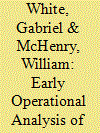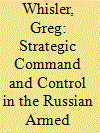|
|
|
Sort Order |
|
|
|
Items / Page
|
|
|
|
|
|
|
| Srl | Item |
| 1 |
ID:
171678


|
|
|
|
|
| Summary/Abstract |
On 30 September 2015, Russian military forces began their overt involvement in the then-four-year-old Syrian Civil War; the subsequent Russian air campaign and political support to the Assad regime are now well documented. However, Russia’s material military support remains largely understudied. This article explores one line of material supported with a demonstrated impact on Syrian Arab Army military operations, as well as Russia’s use of Syria as a sandbox for promoting its defense industry. This article seeks to analyze the deployment, impact, and use of half a dozen T-90A main battle tanks provided to Syrian government forces and their allies in November 2015. It argues that the provision of this weapon played a role in the regime’s significant victories on the battlefield — and assesses their impact on the battle of Aleppo (19 July 2012–22 December 2016). Its performance on the battlefield likely served as a positive showcase for the platform, which contributed to a series of considerable arms deals of the platform to states across the Middle East and South and East Asia. Finally, our research demonstrates the extent to which this platform was utilized by various pro-regime proxy forces in Syria, including those closely linked to the Islamic Revolutionary Guard Corps (IRGC).
|
|
|
|
|
|
|
|
|
|
|
|
|
|
|
|
| 2 |
ID:
171684


|
|
|
|
|
| Summary/Abstract |
In June 1940, Vyacheslav Molotov demanded access to the nickel resource in Finnish Petsamo. Just three months earlier, the area had been returned to Finland as part of the Moscow Peace Treaty. What had changed to ignite Molotov’s interest? Geopolitical factors have traditionally been accorded weight in explanations of the Soviet turnaround. This article, however, contends that power politics cannot fully account for the sudden Soviet interest, but that industrial aspirations must also be considered. In October 1944, Finnish Petsamo became Soviet Pechenga, and was hastily enrolled in the planned economy. Moscow’s sustained interest in the area while it was controlled by Nazi forces, would suggests that industrial ambitions were always at the core of Soviet designs on Petsamo.
|
|
|
|
|
|
|
|
|
|
|
|
|
|
|
|
| 3 |
ID:
171681


|
|
|
|
|
| Summary/Abstract |
The article seeks to explore the evolving defense relationship between Russia and China in the context of nuclear policy doctrine. There are multiple studies of nuclear doctrine in relation to each country, yet this article tries to connect them in the sense of consiring the possible influence of Moscow’s nuclear doctrine on Beijing. In doing this, the author examines the nature of the growing ‘strategic partnership’ between Russia and China to include tracing its origins, limits, and ambiguity and the speculative question of an emerging ‘de facto alliance’. It outlines the growth in military-to-military contacts, developing joint military exercises both bilateral and multilateral, as well as Moscow’s decision to involve China in its annual strategic level military exercises, contrasting Vostok 2010 and Vostok 2018. Indeed, there is a policy perception in Western government circles, particularly in the United States, that should war erupt with Russia that the latter will find itself alone; this is certainly open to question and potentially a dangerous oversight in Washington policy circles, as well as among its allies. The article also raises important questions concerning Moscow’s continued adherence to the undeclared nuclear policy of ‘escalate-to-de-escalate’ and its further strengthening of the conventional level of ‘pre-nuclear’ deterrence. In essence, this article raises questions of interest in the policy and scholarly communities, rather than proving concrete conclusions.
|
|
|
|
|
|
|
|
|
|
|
|
|
|
|
|
| 4 |
ID:
171682


|
|
|
|
|
| Summary/Abstract |
This article is the second in a series of three that examines the Russian Armed Forces’ efforts to adjust its strategic command and control architecture in the post-Soviet period, taking into account wide-ranging shifts in force structure, missions, geography, resources, and leadership. From 2007 through late 2012, the Russian military was gripped with sweeping, painful, and controversial reforms implemented by Defense Minister Anatoliy Serdyukov and Chief of the General Staff Nikolay Makarov. Among many drastic changes, Serdyukov and particularly Makarov finally re-apportioned strategic C2 responsibilities between the General Staff, military districts, and service Main Commands. The latter were relegated largely to ‘train and equip’ roles, while the military districts became truly ‘joint’ commands, and the General Staff became the authority for all operational and strategic planning. The reforms were nascent by the time of abrupt military leadership changes in late 2012 and were not without flaws, but they were a critical breakthrough that simplified and rationalized roles and responsibilities at the highest levels of the Russian military.
|
|
|
|
|
|
|
|
|
|
|
|
|
|
|
|
| 5 |
ID:
171679


|
|
|
|
|
| Summary/Abstract |
The war in the east of Ukraine is now in its sixth year, and despite the cost-benefit logic for both sides of securing a peace, the chances of terminating this conflict remain remote. Using the theoretical literature on war termination, this article demonstrates that the problems of resolving the conflict in the Donbas lie in complex structural issues that are not easy to resolve. To make this argument, this article examines the problems of bringing the conflict to an end by framing the problems according to four key questions: Is war working for the belligerents; Is there a peace to be made; Is peace too costly; Can the war be stopped?
|
|
|
|
|
|
|
|
|
|
|
|
|
|
|
|
| 6 |
ID:
171685


|
|
|
|
|
| Summary/Abstract |
Although Bulgaria was inducted into the Axis, the country managed craftily to avoid sending military contingents against Soviet Russia. Instead, the Bulgarian army sent multiple groups of officers to the German-Soviet front. An instrumental figure was the Chief of the General Staff, Lieutenant-General Konstantin Lukash, who ‘went East’ in 1941. The Bulgarian officers were received at a high level in two Army Groups, complimented and treated with respect throughout. Nevertheless, they witnessed the horror of the German occupation of the USSR. After 1945, Lukash’s unpublished diary was buried in an archive. This article presents new archival evidence to show that the status of Bulgaria as a complete non-belligerent should be reconsidered to a limited degree.
|
|
|
|
|
|
|
|
|
|
|
|
|
|
|
|
|
|
|
|
|